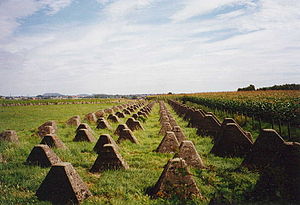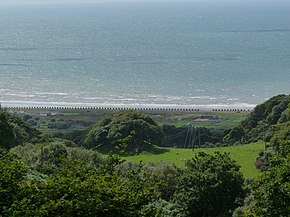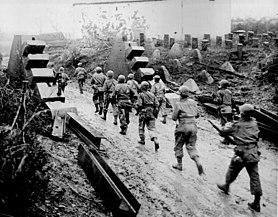Dragon's teeth (fortification)

Dragon's teeth (German: Drachenzähne) are square-pyramidal fortifications of reinforced concrete first used during the Second World War to impede the movement of tanks and mechanised infantry. The idea was to slow down and channel tanks into killing zones where they could easily be disposed of by anti-tank weapons.
They were employed extensively, particularly on the Siegfried Line.[1][2][3]
World War II[]
Dragon's teeth were used by several armies in the European Theatre. The Germans made extensive use of them on the Siegfried Line and the Atlantic Wall. Typically, each "tooth" was 90 to 120 cm (3 to 4 ft) tall, depending on the precise model.
Land mines were often laid between the individual "teeth", and further obstacles were constructed along the lines of "teeth", such as barbed wire to impede infantry or diagonally-placed steel beams to further hinder tanks. Many were laid in the United Kingdom in 1940–1941, as part of the effort to strengthen the country's defences against a possible German invasion.
Behind minefields were the dragon's teeth. They rested on a concrete mat between ten and thirty meters wide, sunk in a meter or two into the ground (to prevent any attempt to tunnel underneath them and place explosive charges). On top of the mat were the teeth themselves, truncated pyramids of reinforced concrete about a meter in height in the front row, to two meters high in the back. They were staggered and spaced in such a manner that a tank could not drive through. Interspersed among the teeth were minefields, barbed wire, and pillboxes that were virtually impregnable by the artillery and set in such a way as to give the Germans crossing fire across the entire front. The only way to take those pillboxes was for infantry to get behind them and attack the rear entry. But behind the first row of pillboxes and dragon’s teeth, there was a second, and often a third, and sometimes a fourth.[4]
Due to the huge numbers laid and their durable construction, many thousands of dragon's teeth can still be seen today, especially in the remains of the Siegfrieds.

World War II dragon's teeth at Fairbourne Beach, Wales, in 2009, designed to stop tanks landing
Dragon's teeth on GHQ Line near Waverley Abbey, Surrey in 2006

United States Army troops passing through dragon's teeth on the Siegfried Line in 1944.
Dragon's teeth from the Alpine Wall
Post World War II[]
Switzerland continues to maintain lines of dragon's teeth in certain strategic areas. In military jargon, these constructions are often referred to as "Toblerone lines", after the chocolate bar.[5]
Dragon's teeth are also present in some areas along the Korean Demilitarized Zone borderline. They were also used on the East German side of the Berlin Wall.
The term has survived into the present day and now also can be used to describe any line of posts or pegs set into the ground to deter vehicle access, for example in rural car parking areas or alongside roads. "Bollard" is another term for such a post.
Some countries, such as those formed after the breakup of Yugoslavia, have movable teeth, positioned at roadsides at strategic locations, which are able to be lifted and placed on the roads.[citation needed]
Some stages of Rallye Deutschland, the German round of the WRC rally championship, are run on roads belonging to the military training ground at Baumholder. The roads are lined with dragon's teeth, known as "Hinkelsteine". They usually serve as obstacles to prevent tanks from leaving the roads, and cause devastation to any rally car which veers off track.[citation needed]
See also[]
References[]
Notes
- ^ Wilson, Joe (1999). The 761st "Black Panther" Tank Battalion in World War II. McFarland. p. 150. ISBN 0786406674.
This section of the Siegfried Line sat in the middle of the Hardt Mountains, where the landscape was dotted with pillboxes and dragon teeth tank obstacles.
- ^ Bohner, Roy. "Baptism of Fire on the Siegfried Line". 11th Armored Division Legacy Group website. Retrieved 26 February 2013.
it was late afternoon on 18 Feb when [we] passed through the Siegfried Line dragons teeth
- ^ Owens, Emiel W. (2006). Blood on German Snow: An African American Artilleryman in World War II and Beyond. Texas A&M University Press. p. 56. ISBN 1585445371.
Human-made obstacles such as the "dragon teeth" were integrated carefully into the defense system of the line.
- ^ Ambrose, Stephen (1998). The Victors: Eisenhower and his Boys — The Men of World War II. New York: Simon & Schuster. pp. 256.
- ^ Muehlemann, Anetka (9 June 2008). "Ligne fortifiée, un témoin du passé à valoriser". 24 Heures (in French). Edipresse, Switzerland. Archived from the original on February 26, 2012. Retrieved 2009-08-09.
This article needs additional citations for verification. (January 2010) |
External links[]
 Media related to Dragon's teeth at Wikimedia Commons
Media related to Dragon's teeth at Wikimedia Commons- The Toblerone trail
- Dragon's Teeth in Horsham, West Sussex
- "You Build 'Em - We'll Bust 'Em." Popular Science, June 1942, pp. 106–112. Field expedient tank traps constructed of logs.
- White Cliffs Underground - Dragon's Teeth and Tank Traps around England's south coast
- Dragons Teeth on Libyan border with Egypt
- "ANTI-TANK OBSTACLES, ISLE OF GRAIN, KENT". English Heritage. Retrieved 28 July 2010.
- Anti-tank obstacles



